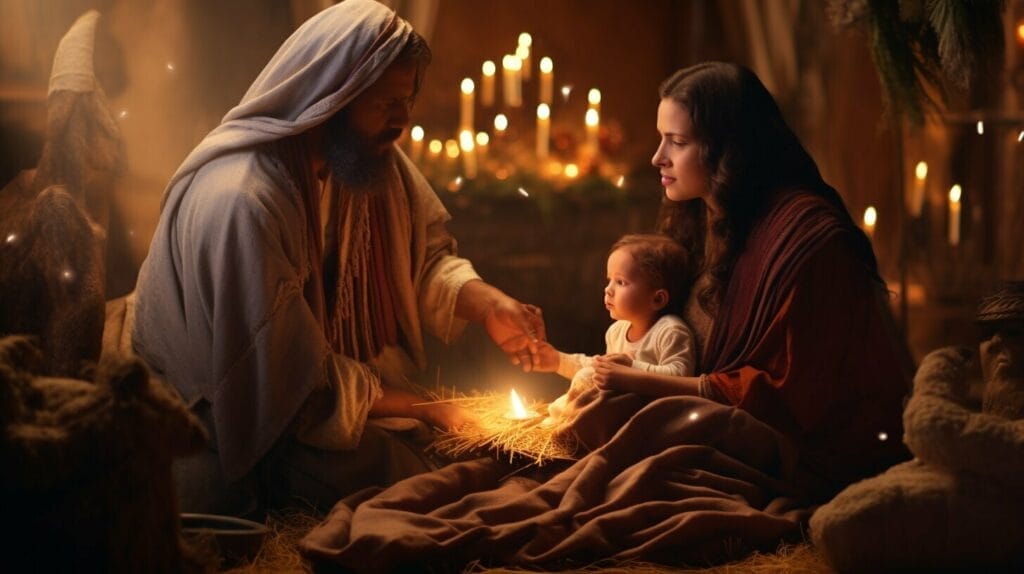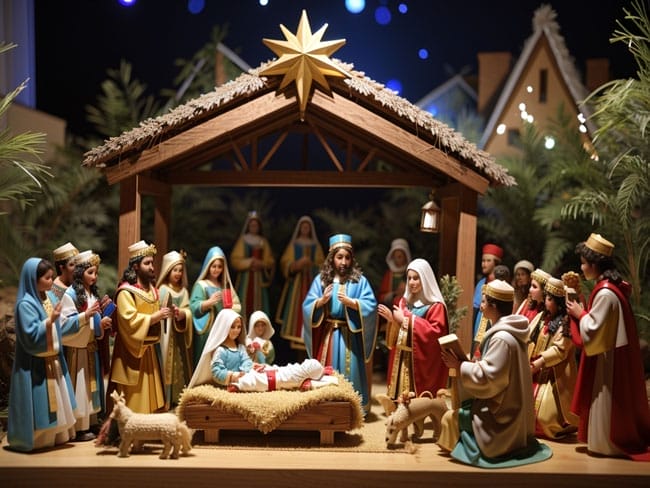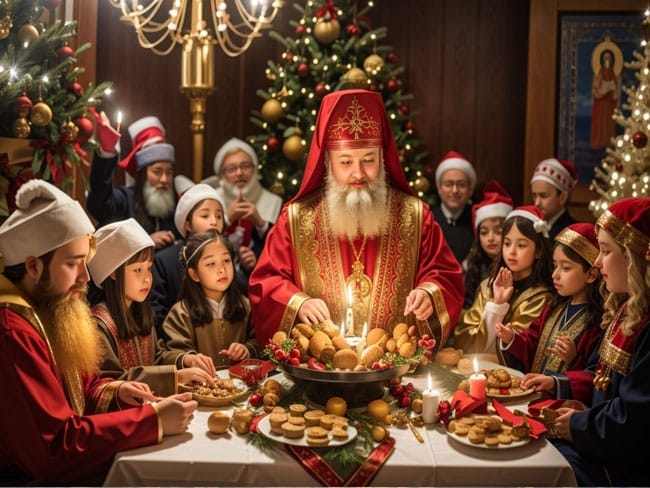How Christian Christmas Traditions Differ Around the World
Christmas is a time of joy and celebration for Christians worldwide. However, the way they celebrate this special occasion can differ greatly. Each country has its unique customs and rituals that make its Christmas traditions special and distinctive.

In this article, we’ll take you on a trip around the world to explore the rich tapestry of Christian Christmas traditions. From Western countries like the United States and the United Kingdom to Eastern Orthodox countries like Greece and Russia, we’ll uncover the unique ways in which Christians celebrate the birth of Jesus Christ.
Key Takeaways:
- Christian Christmas traditions vary widely across the globe.
- Each country has its unique customs and rituals that make their Christmas traditions special and distinctive.
- From Western countries like the United States and the United Kingdom to Eastern Orthodox countries like Greece and Russia, we’ll uncover the unique ways in which Christians celebrate the birth of Jesus Christ.
The Significance of Christmas in Christianity
As a Christian, Christmas is one of the most important holidays on your calendar. It commemorates the birth of Jesus Christ, the Son of God, who came to Earth to save humanity from sin and death. The birth of Jesus is a central event in Christian history and theology, and it holds deep spiritual significance for believers.
For many Christians, Christmas is more than just a holiday. It’s a time to reflect on the love and mercy of God, to recommit to living a life of faith and service, and to celebrate the joy and hope that Jesus brings to the world.
Throughout history, Christians have celebrated Christmas in different ways, with various customs and rituals that reflect their unique cultures and beliefs. Whether you are a Catholic, Protestant, Orthodox, or any other kind of Christian, you likely have your own traditions and practices that are meaningful to you and your community.
So, as you prepare for the holiday season, take some time to reflect on the significance of Christmas in your faith. Consider attending a Christmas Eve service or Midnight Mass, reading the story of Jesus’ birth in the Bible, or sharing the story of Christmas with your family and friends. By doing so, you will deepen your understanding of the true meaning of Christmas and honor the sacredness of the holiday.
Traditional Christmas Customs in Western Christianity

Western Christian countries, such as the United States, United Kingdom, and Canada, have a rich history of traditional Christmas customs that are deeply ingrained in their festive celebrations. These customs are often passed down through generations, bringing a sense of continuity and connection to the past.
One of the most recognizable Christmas customs is the decorating of a Christmas tree. This tradition is said to have originated in Germany in the 16th century and was introduced to England by Queen Victoria’s German husband, Prince Albert. Today, Christmas trees are a staple of Western Christmas celebrations, with families often gathering together to decorate the tree with lights, tinsel, and ornaments.
Similarly, the exchanging of gifts on Christmas day is another beloved custom in Western Christianity. This tradition is thought to have originated with the three wise men who brought gifts to baby Jesus, and has since become a way for people to express their love and appreciation for one another during the holiday season.
Another popular tradition is the singing of Christmas carols, which dates back to medieval times when traveling musicians would perform songs about the birth of Jesus. Today, carolers can be heard singing classic tunes like “Silent Night” and “Joy to the World” throughout Western Christian communities.
Traditional Christmas Customs in Western Christianity
In addition to these customs, Western Christians also celebrate with special foods and drinks. For example, in the United States, Christmas dinner often includes roasted turkey or ham, mashed potatoes, and cranberry sauce. In the United Kingdom, Christmas pudding and mince pies are popular dessert options, while Canadians may indulge in tourtière, a meat pie with origins in Quebec.
Overall, these traditional Christmas customs serve as a way for Western Christians to connect with their faith, their families, and their communities during the holiday season. Through these practices, they come together to celebrate the birth of Jesus and the hope and joy that he represents.
Nativity Scenes and Pageants: Celebrating the Birth of Jesus
One of the most beautiful and significant Christmas traditions in Christianity is the reenactment of the birth of Jesus through nativity scenes and pageants. The nativity scene depicts the holy family in a stable, with the baby Jesus in a manger, surrounded by animals and wise men bearing gifts. Pageants, on the other hand, are live performances that depict the story of the Nativity, often involving children dressed up as the characters.

These traditions have been an integral part of Christmas celebrations for Western Christians, and they date back to the 13th century. St. Francis of Assisi is believed to have created the first nativity scene in Italy, which later spread throughout Europe and beyond.
Through nativity scenes and pageants, Christians remember and celebrate the birth of Jesus Christ, the savior of the world. It is also a time for families and communities to come together and share the joy of the season.
Fun Fact: In some Latin American countries, it is common to hold a procession with a live baby in a crib, who is then presented to the priest during the Christmas Eve Mass.
Midnight Mass and Christmas Eve Services
Attending Midnight Mass or a Christmas Eve service is a cherished part of Christian festive traditions. For many Christians, these gatherings offer a moment of solemnity and reflection, a time to gather with loved ones and celebrate the true meaning of Christmas.
The tradition of Midnight Mass dates back to the fourth century when Christians in Rome celebrated the birth of Christ at midnight on December 25th. Today, it remains a significant part of the Catholic and Anglican churches, with services featuring special hymns, scripture readings, and the lighting of candles.
Christmas Eve services at Protestant churches also tend to be solemn and reflective, featuring traditional hymns and scripture readings. Some churches offer a candlelight vigil, where worshippers hold candles as a symbol of the light of Christ.
These sacred gatherings bring communities together and create a sense of unity and togetherness, making them an integral part of Christmas celebrations for Christians around the world.
La Navidad: Celebrating Christmas in Hispanic Cultures
Christmas in Hispanic cultures is a vibrant and joyous occasion, filled with unique traditions that blend faith, family, and festivities. La Navidad, as it is known in Hispanic communities, is a time to celebrate the birth of Jesus Christ and come together with loved ones.

One of the most beloved La Navidad customs is Las Posadas, a reenactment of Joseph and Mary’s search for lodging in Bethlehem. The nine-night celebration involves processions, carol singing, and the breaking of piñatas filled with sweets and fruits.
Nochebuena, or Christmas Eve, is another significant part of Hispanic Christmas traditions. Families gather to share a feast, which often includes traditional dishes such as tamales, bacalao, and lechón. Midnight Mass, or La Misa de Gallo, is also a part of Nochebuena celebrations, where the faithful gather to welcome the newborn Jesus.
The Nativity scene, or El Nacimiento, is an integral part of La Navidad in Hispanic cultures. These elaborate displays depict the arrival of Mary and Joseph in Bethlehem, with various figures representing the shepherds, angels, and the Three Wise Men. It is a cherished tradition to add pieces to the Nativity scene each year, creating a family heirloom.
As you can see, La Navidad is a unique expression of Christian Christmas traditions that reflect the rich history and culture of Hispanic communities. The celebrations are a beautiful reminder of the universal message of love, hope, and peace that the birth of Jesus Christ brings to the world.
Eastern Orthodox Christmas Traditions
If you thought Christmas was celebrated on December 25th everywhere, you’re in for a surprise. Eastern Orthodox Christians celebrate Christmas on January 7th, following the Julian calendar. This means that their Christmas traditions are slightly different from the Western Christian traditions.

The Eastern Orthodox Christmas rituals begin on Christmas Eve with the Great Compline service, which is followed by a fasting period until the first star appears in the sky. Then, families gather for a celebratory feast, which typically includes meat dishes that have been abstained from during the Advent fast.
On Christmas Day, worshippers attend church services, followed by an exchange of gifts and visits to family and friends. One of the most significant Eastern Orthodox Christmas traditions is the lighting of the Paschal candle, symbolizing the light of Christ spreading throughout the world.
Despite the differences in dates and customs, Christmas remains a time of religious significance and joy for Eastern Orthodox Christians around the world.
Christmas in Africa: A Blend of Faith and Culture
Christmas in Africa is a beautiful blend of faith and culture, with celebrations that reflect the vibrant diversity of this vast continent. While Christianity is the predominant religion in many African countries, Christmas traditions often incorporate local customs and traditions, resulting in unique and colorful celebrations.
One of the most popular traditions is the colorful procession of the Christ Child, where children parade through the streets in honor of the birth of Jesus. In some countries, such as Ghana and Cameroon, this is accompanied by joyful singing and dancing.
In Ethiopia, where the Orthodox Church celebrates Christmas on January 7th, it is customary to fast beforehand and then attend a special church service on Christmas Eve. The day itself is celebrated with feasting, family gatherings, and the exchange of gifts.
In South Africa, the Christmas feast often includes roast lamb, a traditional dish that reflects the country’s farming heritage. Carols by candlelight services are popular, with participants lighting candles and singing under the stars.
While Christmas in Africa varies from country to country, the common thread of faith and community is woven throughout. It is a time to come together with loved ones, to give thanks for the blessings of the past year, and to celebrate the birth of Jesus Christ.
Christmas Traditions in Asia: Embracing Christianity
Despite being a minority religion in many Asian countries, Christianity has gradually gained a foothold in the region, and Christmas is now widely celebrated in many countries.
In South Korea, for instance, Christmas is primarily a religious holiday, marked by church services, caroling, and the exchange of gifts. One unique tradition is the lighting of lotus-shaped lanterns in the weeks leading up to Christmas, which symbolize the hope and peace that the holiday brings.
In the Philippines, where over 80% of the population is Christian, Christmas is the most important holiday of the year, celebrated over a period of several months. The Novena Masses, or Simbang Gabi, are particularly significant, with Catholics attending pre-dawn masses for nine consecutive days before Christmas Day.
Meanwhile, in India, which has a small but growing Christian population, Christmas is a national holiday, and many urban areas are decked out in festive lights and decorations. Christians go to Midnight Mass, often accompanied by non-Christian friends and family members who appreciate the holiday as a time of peace and goodwill.
As in other parts of the world, local cultures have influenced the way Christians celebrate Christmas in Asia. For example, in Japan, where Christianity has only a small following, the holiday is increasingly popular as an occasion for romantic dates and gift-giving, rather than a religious festival.
Regardless of where and how it is celebrated, however, Christmas remains a special time for Christians across the globe, a chance to come together, reflect on their faith, and share in the joy of the holiday.
Celebrating Christmas Down Under: Australian and New Zealand Traditions
If you’re from the Northern Hemisphere, the idea of a summertime Christmas might seem strange. But for Australian and New Zealand Christians, it’s a beloved part of their holiday season. As you explore the unique Christmas traditions of these countries, you’ll see that while some of the customs may seem familiar, others are decidedly different.
One of the most iconic symbols of an Australian Christmas is the Christmas bush. This native shrub is covered in small white flowers in December, which gradually turn red, symbolizing a festive transformation. Along with the Christmas bush, many Australians decorate their homes with tinsel and fairy lights, creating a bright and cheerful atmosphere.
On Christmas Day, many Australians gather together for a feast, often featuring roast meats, vegetables, and Christmas pudding. But what really sets Australian Christmas celebrations apart is the tradition of heading to the beach or the local park for a picnic or barbecue. This reflects the laid-back, outdoorsy lifestyle that many Australians enjoy.
In New Zealand, Christmas falls during the summer months as well, and many of the same traditions are observed. Decorating with lights and tinsel is common, as is gathering with family and friends for a festive meal. But like in Australia, there are also unique customs to be found.
One of the most popular Christmas events in New Zealand is the Christmas in the Park concert series. Held in several cities throughout the country, these concerts feature popular music acts, fireworks, and a lively atmosphere that brings people of all ages together. In addition, many New Zealanders celebrate the Maori tradition of the “Way of the Cross,” a solemn procession that takes place on Christmas Eve.
Whether you’re celebrating Christmas in the Northern or Southern Hemisphere, the core of the holiday remains the same: the commemoration of the birth of Jesus Christ. And as you see the many ways that Christians around the world observe this sacred occasion, you’ll realize that the true spirit of Christmas is universal.
Amidst the differences in customs and cultures, the true spirit of Christmas shines through. The unifying thread of faith and the joy of the season connects people worldwide, reminding us that we are all part of a larger global community.
As you gather with family and friends this Christmas, take a moment to reflect on the beauty and significance of these cherished traditions. Let the spirit of love, hope, and peace fill your heart, and may the joy of the holiday season continue to inspire you throughout the year.
FAQ
Q: How do Christian Christmas traditions differ around the world?
A: Christian Christmas traditions vary widely across the globe, reflecting the diverse cultures and customs of believers. Each country has its unique customs, rituals, and celebrations that incorporate elements of faith and culture. From nativity scenes to midnight Mass, Christians around the world find their own special ways to celebrate the joy and hope of Christmas.
Q: Why is Christmas significant in Christianity?
A: Christmas holds great significance in Christianity as it commemorates the birth of Jesus Christ, who is considered the Son of God and the Savior of humankind. It is a time when Christians remember and celebrate the fulfillment of God’s promise to send a Savior to bring salvation and hope to the world. Christmas is a central part of the Christian faith, and the holiday season is a time for believers to reflect on the love and grace of God.
Q: What are some traditional Christmas customs in Western Christianity?
A: Traditional Christmas customs in Western Christianity include decorating Christmas trees, exchanging gifts, singing carols, attending church services, and gathering with family and friends. These customs have evolved over time and have become beloved traditions that symbolize the joy and togetherness of the Christmas season.
Q: How do Christians celebrate the birth of Jesus through nativity scenes and pageants?
A: Nativity scenes and pageants are popular ways for Christians to celebrate the birth of Jesus. Nativity scenes depict the manger scene with figures representing Mary, Joseph, baby Jesus, the shepherds, and the wise men. Pageants involve a live reenactment of the nativity story, with participants dressing up as the characters and performing a scripted play or musical. These traditions allow believers to visually and theatrically retell the story of Jesus’ birth, bringing the narrative to life.
Q: What is the importance of Midnight Mass and Christmas Eve services?
A: Midnight Mass and Christmas Eve services hold a special place in the Christian faith. They are sacred gatherings where believers come together to worship and celebrate the birth of Jesus. Midnight Mass is traditionally held at midnight on Christmas Eve and marks the beginning of Christmas Day. It is a time of reflection, prayer, and communion. Christmas Eve services are held earlier in the evening and allow families and communities to come together for worship, singing carols, and sharing in the joy of the season.
Q: How do Hispanic cultures celebrate Christmas (La Navidad)?
A: Hispanic cultures have vibrant and joyful Christmas traditions known as La Navidad. These traditions include Las Posadas, where the journey of Mary and Joseph seeking lodging is reenacted; Nochebuena, a festive family gathering on Christmas Eve; and the celebration of Three Kings’ Day on January 6th. These customs blend faith, family, and festivities, creating a unique and spirited Christmas celebration.
Q: What are some Christmas traditions in Eastern Orthodox Christianity?
A: Eastern Orthodox Christians celebrate Christmas on a different date than Western Christians, following the Julian calendar. They have beautiful traditions, such as the feast of the Epiphany, where the baptism of Jesus is commemorated, and the lighting of the Paschal candle, symbolizing the light of Christ. The Orthodox Christmas celebrations are rich in symbolism and are an important part of their religious calendar.
Q: How is Christmas celebrated in Africa?
A: Christmas celebrations in Africa blend Christianity with local customs, resulting in unique and vibrant traditions. African communities incorporate traditional dances, vibrant processions, and joyful singing into their Christmas celebrations. The focus is on faith, community, and the celebration of the birth of Christ.
Q: How is Christmas embraced in Asian countries?
A: Christianity has gained a presence in many Asian countries, and Christmas is embraced as a religious celebration. Countries like South Korea and the Philippines have their unique customs and traditions associated with Christmas. These can include attending church services, decorating homes and streets with lights, and engaging in charitable activities. It is a time for Asian Christians to express their faith and celebrate the birth of Jesus.
Q: How is Christmas celebrated in Australia and New Zealand?
A: Christmas in the Southern Hemisphere, particularly in Australia and New Zealand, coincides with summer. This unique climate brings about distinct traditions such as beach barbecues, outdoor activities, and carol singings in parks or on the beach. Australian and New Zealand Christians embrace these traditions while still incorporating the religious significance of Christmas into their celebrations.




